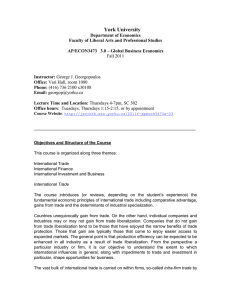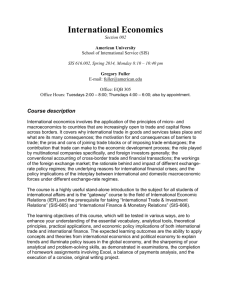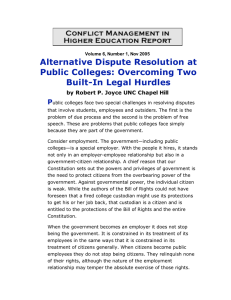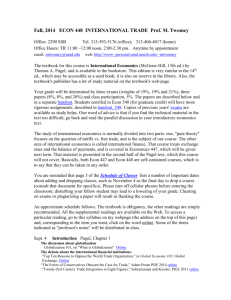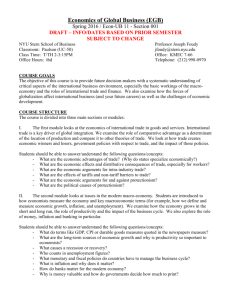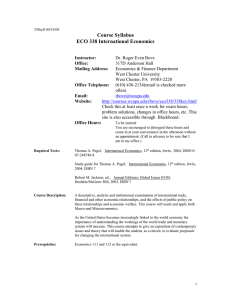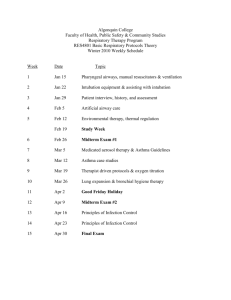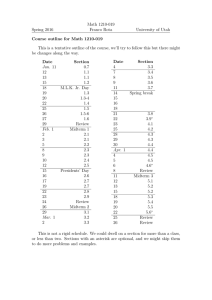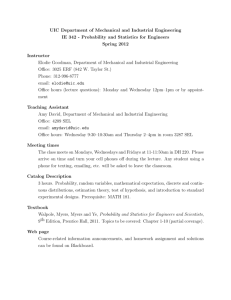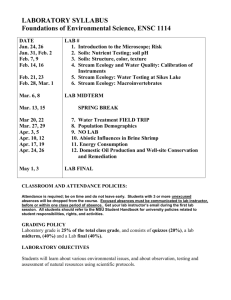FBE 462 – International Trade and Commercial Policies Spring 2013
advertisement
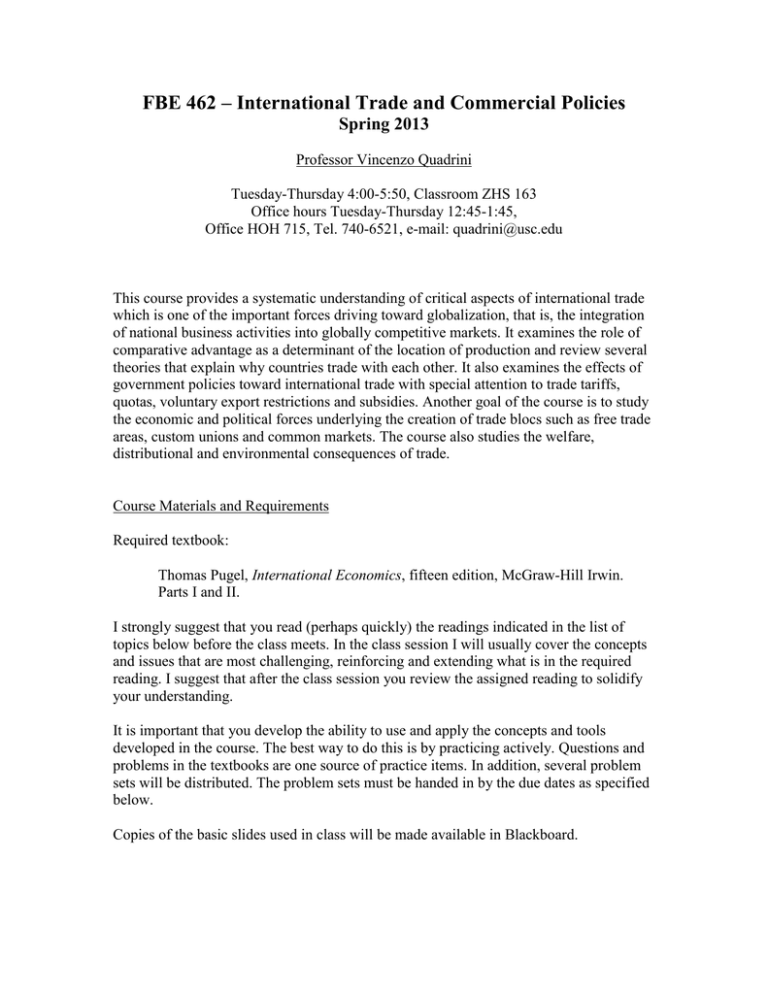
FBE 462 – International Trade and Commercial Policies Spring 2013 Professor Vincenzo Quadrini Tuesday-Thursday 4:00-5:50, Classroom ZHS 163 Office hours Tuesday-Thursday 12:45-1:45, Office HOH 715, Tel. 740-6521, e-mail: quadrini@usc.edu This course provides a systematic understanding of critical aspects of international trade which is one of the important forces driving toward globalization, that is, the integration of national business activities into globally competitive markets. It examines the role of comparative advantage as a determinant of the location of production and review several theories that explain why countries trade with each other. It also examines the effects of government policies toward international trade with special attention to trade tariffs, quotas, voluntary export restrictions and subsidies. Another goal of the course is to study the economic and political forces underlying the creation of trade blocs such as free trade areas, custom unions and common markets. The course also studies the welfare, distributional and environmental consequences of trade. Course Materials and Requirements Required textbook: Thomas Pugel, International Economics, fifteen edition, McGraw-Hill Irwin. Parts I and II. I strongly suggest that you read (perhaps quickly) the readings indicated in the list of topics below before the class meets. In the class session I will usually cover the concepts and issues that are most challenging, reinforcing and extending what is in the required reading. I suggest that after the class session you review the assigned reading to solidify your understanding. It is important that you develop the ability to use and apply the concepts and tools developed in the course. The best way to do this is by practicing actively. Questions and problems in the textbooks are one source of practice items. In addition, several problem sets will be distributed. The problem sets must be handed in by the due dates as specified below. Copies of the basic slides used in class will be made available in Blackboard. Course Requirements and Grading The course grade will be based on the following weighted items: 1. First mid-term examination (February 19) 2. Second mid-term examination (April 2) 3. Final examination (May 9) 4. One group assignment 5. Five problem sets 6. Class attendance, participation and presentation 25% 25% 25% 10% 10% 5% It is highly recommended to keep up with current developments in the international environment, both for class purposes and for your own benefit. You can do this by reading the relevant articles in newspapers (e.g., Financial Times, Wall Street Journal, New York Times) or weekly magazine (e.g., the Economist). To encourage the readings of news and the applications of theory to the real world, students are encouraged to make inclass presentations of issues recently covered in the news that are related to the topics of the course. We will use the last 15 minutes of class for these presentations. The presentation can be done in groups of 2, 3 or 4 students. The groups can be the same as the ones for the group assignment. The two midterm exams and the final exam are non-cumulative and will address the subject matter that precedes them. For all the exams, you are responsible for the assigned textbook chapters, any material covered in class. The exams are intended to assess how well you understand the basic ideas and principles. All exams are closed-book, closed notes. You may use a calculator but not a cell phone, laptop, or any other electronic device. Important dates for course requirements Problem set 1 Problem set 2 Midterm exam 1 Group assignment Problem set 3 Problem set 4 Midterm exam 2 Problem set 5 Final Exam January 24 February 14 February 19 February 28 March 7 March 28 April 2 May 2 May 9, 4:30-6:30 Class Etiquette No laptops or other internet access devices can be used in class. Please turn off your cellular phones. Topical Organization (tentative) PART I: THEORIES OF INTERNATIONAL TRADE 1. Introduction: International Linkages and Globalization (Jan. 10) Required reading: Pugel, Chapter 1 2. The Basic Theory Using Demand and Supply (Jan. 15) Industry demand and consumer surplus. Industry supply and producer surplus. Free trade equilibrium and the net national gains from trade. Required reading: Pugel, Chapter 2. Practice Questions and Problems: 1-12. 3. Why Countries Trade (Jan. 17, 12, 24) Adam Smith’s theory of absolute advantage. Ricardo’s theory of comparative advantage. Heckscher-Ohlin theory of factor proportions. Required reading: Pugel, Chapters 3 and 4. Practice Questions and Problems: 1-10 (ch. 3). Practice Questions and Problems: 1-8 (ch. 4). 4. Who Gains and Who Looses from Trade and Test of the H-O Theory (Jan. 29) Short-term welfare consequences. Long-term welfare consequences. Are the predictions of the H-O theory supported by the trade data? Required reading: Pugel, Chapter 5. Practice Questions and Problems: 1-6, 8-10. 5. Alternative Theories of Trade (Feb. 5, 7) Increasing intra-industry trade and the limits of the Heckscher-Ohlin’s theory. Economies of scale. Monopolistic competition. Oligopoly and international trade. External scale economies. Required reading: Pugel, Chapter 6. Practice Questions and Problems: 1-10. 6. Growth and Trade (Feb. 12) Required reading: Pugel, Chapter 7. Practice Questions and Problems: 1-12. 7. Review in preparation for the first midterm exam (Feb. 14) 8. First midterm exam (Feb. 19) PART II: TRADE POLICIES 1. The Analysis of Tariffs (Feb. 21, 26) The effects of tariffs on producers, consumers and government revenues. The net national consequences of tariffs. The nationally optimal tariff. Required reading: Pugel, Chapter 8. Practice Questions and Problems: 1-8. 2. Nontariff Barriers to Imports (Feb 28, Mar. 5) Import quota Import quotas versus tariffs Voluntary export restraints (VERs) Other nontariff barriers Required reading: Pugel, Chapter 9. Practice Questions and Problems: 1-7. 3. Arguments for and against Protection (Mar. 7) The real world is not first best. Promoting domestic production or employment. The infant industry argument. The dying industry argument and adjustment assistant. The need to raise revenues from the government. The politics of protection. Required reading: Pugel, Chapter 10. 4. Pushing Exports (Mar. 12) Dumping and antidumping policies. Exports subsidies. Countervailing duties. Required reading: Pugel, Chapter 11. Practice Questions and Problems: 1-5. 5. Trade Blocs and Trade Blocks (Mar. 14, 26) Free-Trade Area, Customs Unions, Common Market, Economic Union. The theory of trade blocks: trade creation and trade diversion. North American Free Trade Agreement (NAFTA) Trade blocks among developing countries. Trade embargoes. Required reading: Pugel, Chapter 12. Practice Questions and Problems: 1-9. 6. Review in preparation for the second midterm exam (Mar. 28) 7. Second midterm exam (April. 2) 8. April 4: No class. Make-up class on May 2. PART III: OTHER TRADE TOPICS 1. The Economic Integration of Europe (Apr. 9) Required reading: Pugel, Chapter 12. 2. Trade and the Environment (Apr. 11) Trade and domestic pollution. Transborder pollution. Global environment challenges. Required reading: Pugel, Chapter 13. Practice Questions and Problems: 1-8. 3. Trade Policies for Developing and Transition countries (Apr. 16) International cartels to raise primary-product prices. Import-substituting industrialization. Export of manufactures to industrial countries. Required reading: Pugel, Chapter 14. Practice Questions and Problems: 1-10. 4. Multinationals, trade in Capital and Migration (Apr. 18, 23) Foreign direct investment (FDI). Multinational enterprises. Taxation of multinational enterprises’ profits. Policies toward FDI. Migration, the labor market and policies toward immigration. Required reading: Pugel, Chapter 15. Practice Questions and Problems: 1-17. Pugel, Chapter 21, first five pages only. 5. Class discussion about outsourcing and globalization (Apr. 25) Required reading: Distributed in class. 6. The Chinese economy and other Asian economies (Apr. 30, May 2) Required reading: Distributed in class. 7. Review in preparation for the final exam (May. 7) 8. Final exam (May 9, 4:30-6:30PM)

